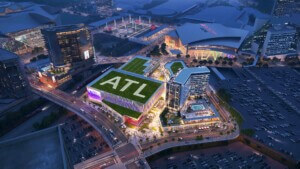A controversial $1.2 billion mixed-use project designed by Los Angeles—based architecture firms P-A-T-T-E-R-N-S and Gensler has won unanimous approval from the Los Angeles City Council, pushing Downtown L.A.’s booming, luxury-driven growth into one of Los Angeles’s most economically disadvantaged neighborhoods.
According to documentation supplied to the City of Los Angeles, the project aims to generate 1,400 market-rate housing units coupled with office, restaurant, and art gallery programs totaling up to 1,664,000-square feet of floor area. The development features a smattering of canted, glass-clad towers surrounded by a mid-rise layer of articulated apartment blocks with punched openings and projecting and recessed volumes.
The project is to be divided up between two adjacent blocks and built in phases, with the so-called “West Block” containing an existing, 12-story, 180,000-square foot office tower with 30,000-square feet of restaurant and retail spaces on the ground floor as well as an 8,000 square foot rooftop terrace and restaurant space. Plans for that site, to be built first, also call for a 20-story, 208-room hotel tower. A shorter, seven-story tall apartment tower containing 100 units and an eight-story, 1,158-stall parking garage with ground floor commercial areas will also occupy the site.
The second phase of the project, referred to in documentation submitted to the city as “East Bock,” will host two towers, 32-stories and 35-stories in height, respectively, adding 895 for-sale units with a cluster of three- to seven-story apartment blocks adding a further 428 rental and 14 live-work units. This block will also contain a four-story subterranean parking garage with 1,354 parking stalls.
With only a paltry five percent of the overall units to be reserved as affordable housing, the project has been controversial among community and working class housing activists due to the impact it will have on current residents’ ability to remain in the area. The project’s size, scale, and location threaten to fracture a largely working class, renter-occupied neighborhood with a relatively low-to-average median income by introducing high-end, transit-oriented development. The developers behind the project have promised to add $15 million to an affordable housing fund as well as providing $3 million for community organizations for job training and youth programs, but activists caution that it will not be enough to stem large-scale displacement.
Construction on the project is due to start by the end of 2017 or early 2017, with the completion of the second phase of the project wrapping up in late 2021.










